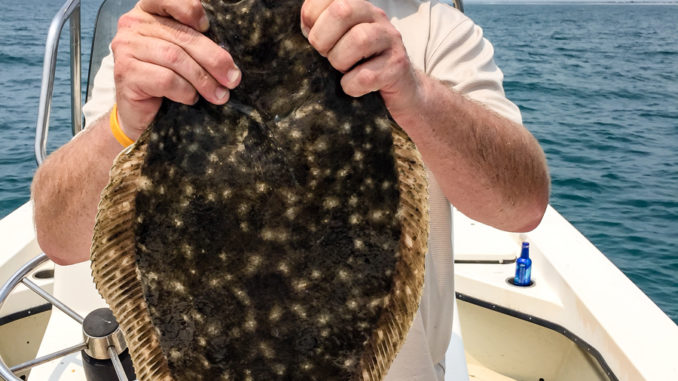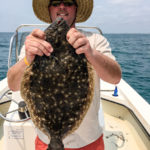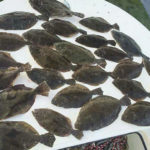
Tired of catching short flounder, head to the reefs and livebottom off Topsail Island for fish big enough to slide a fillet knife through.
Short flounder got you down? Tired of busting your hump to catch a keeper? You may need a change of scenery.
A good GPS and reliable coordinates for the artificial reefs and live bottoms off New Topsail and New River inlets will steer you in the right direction — to flounder that are more likely to be keepers and possibly the biggest you’ve ever caught.
But while most anglers bottom-fishing for black sea bass, drifting for king mackerel or trolling for Spanish mackerel are dialed in on the structure, guide Wayne Crisco of Hampstead is more interested in the areas surrounding it.
“Flounder don’t stack up on structure,” said Crisco, who runs Last Resort Charters. “They’re lying in an ambush position around the edges, waiting for the current to bring the bait to them.
“The Surf City Ledge, Diver’s Rock — most of the popular places that people bottom-fish have flounder. They just don’t take the time to find them. I also fish the Liberty Ship and the Billy Murrell reef. There are at least seven places in a 15-mile span.
“I do fish a lot of ARs,” said Crisco, “but any livebottom that has a little structure and some bait, and you’re apt to find flounder nearby. You don’t necessarily have to go to a reef or a wreck; it can be one little knot that drops off 2 feet outside of the inlet, and there could be 15 to 20 fish around it. A submerged piling or even a tire will attract what bait is out there, and the flounder will key on it.”
Be it ledge or wreck, flounder arrange themselves in basically the same fashion, according to Crisco. Using the structure or depression as a current break, flounder lie motionless, waiting for tidal movement to deliver them an easy meal they can dart out and grab. With that in mind, Crisco pays close attention to the tides.
“You don’t want a ripping tide,” Crisco said, “but you don’t want a slack tide, either. When the tide gets slack, the flounder go through a transition period. You go from catching a lot of fish to catching a lot of trash fish when it’s barely moving. That’s when I start drifting to cover more bottom, but you will literally have to hit them in the nose with it. As soon as the current picks up, it’ll be back on again.”
The recent resurgence of black sea bass has led to their swarming of artificial reefs. This is good news to some, but Crisco admits it’s thrown flounder fishermen a bit of a curveball.
“A flounder will not lay under 10,000 sea bass where it’s going to have to fight for every piece of food it gets,” he said. “I can still fish that area, but not that immediate area. I might have to move my anchor position several times to get away from them, but I find a lot more flounder when I do.”
To reach flounder in 20 to 50 feet of water, Crisco’s go-to bait is a white, 2-ounce, Betts Flounder Fanatic bucktail tipped with a white, 5-inch Gulp swimming mullet or a live bait like mullet minnows or a menhaden. However, if he finds flounder close enough to structure to be hazardous to his equipment, he’ll switch over to a more-economical Carolina rig.
“I prefer mullet on a Carolina rig,” Crisco said, “but a pogey will work. With live bait, you just use the current. Throw it out with the tide and let the current bring it back to you. If you’re bucktailing, it’s more like vertical jigging. For a Carolina rig, I like a ¾- to 1-ounce egg sinker, a 100-pound barrel swivel, 8 to 10 inches of 20-pound monofilament for the leader, and a No. 1 Eagle Claw Lazer Sharp Kahle hook.”
Although coordinates and a chart plotter will put you in the right neighborhood, finding the structure and the areas holding flounder requires a quality depth finder.
“I use a Lowrance HDS,” Crisco said. “If there is an 8-inch drop, it will mark it on the screen. If there is a school of sea bass, it will mark it as a big cloud of green. If it’s hard bottom, I can tell by the color.”
One of the best attributes of nearshore flounder fishing is that it only gets better as the summer continues.
“I think a lot of the bigger fish push inshore early in the year and then push back outside when the water temperatures go up,” Crisco said. “When people start catching a lot of little fish inshore, that’s a good sign that the bigger fish are outside the inlets. The hotter the better for offshore flounder, and the fish are more aggressive because most of the bait is inside.”
DESTINATION INFORMATION
HOW TO GET THERE — Topsail Island is south of Onslow Beach and north of Lea Island, about 25 miles north of WIlmington. Three towns — North Topsail Beach, Surf City and Topsail Beach — are scattered along the island. US 17 and NC 210 provide access to the northern end of the island, and US 17 and NC 50 lead visitors to Surf City. A public boat ramp is under the NC 210 high-rise bridge, and Soundside Park has a public ramp on the island side of the NC 50 swing bridge. Topsail Beach has a public ramp off South Anderson Blvd.
WHEN TO GO — June begins great flounder fishing on the nearshore reefs off Topsail Island, and fishing improves through the summer as rising inshore water temperatures push more fish into the ocean.
BEST TECHNIQUES — Anchor up around reefs and wrecks with an appropriate anchor, then target the flat, sandy bottoms around reefs, plus the drops of ledges, in the lee of the current. Vertically jig 2-ounce bucktails with soft-plastic trailers or make short casts with Carolina rigs baited with mullet or menhaden. A 1-ounce weight will do fine above an 8- to 10-inch leader of 20-pound mono and a No. 1 Kahle hook. Flounder are managed by a 6-fish daily creel limit and a 15-inch minimum length.
FISHING INFO/GUIDES — Wayne Crisco, Last Resort Charters, 910-465-0611, www.lastresortcharters.com; East Coast Sports, 910-328-1887, www.eastcoastsports.com. See also Guides and Charters in Classifieds.
ACCOMMODATIONS — Holiday Inn Express and Suites, Sneads Ferry, 888-465-4329, www.hiexpress.com/sneadsferrync; Tiffany’s Motel, 800-758-3818, www.tiffanysmotel.com; Island Inn, 800-573-2566, www.topsailislandinn.com.
MAPS — Sealake, 800-411-0185, www.thegoodspots.com; Captain Segull’s Nautical Sportfishing Charts, 252-288-5918, www.captainsegullcharts.com; GMCO’s Chartbook of North Carolina, 888-420-6277, www.gmcomaps.com.







Be the first to comment